Market Insight: Guest Articles
Space Planning: How Much Space Do You Really Need?
by Ned Fennie, Jr.
Co founder FENNIE+MEHL Architects
January 2005
At the onset of a search for office space a real estate broker will invariably want to know right away how much space will be needed by the prospective tenant. If you have been through this estimating the right amount of space required for a new facility can be tricky. Leasing too much space and cash flow can be hobbled by an excessive rent payment and under-utilized space, too little space and staffing growth will be limited. This may result in the need to relocate, prior to your lease expiration—potentially a very expensive exercise. Adding the architect to your leasing team early in the process to develop reliable space requirements (before you begin looking at potential lease spaces) can make all the difference in leasing the right size and type facility for your company.
If you are the owner of the company, an experienced architect will arm you up front with all the crucial information, so you can confidently make the correct strategic real estate decisions for your firm. This will save you precious time and effort. Having this information in hand when you begin looking for space will allow you to pre-screen potential lease spaces and quickly zero in on only those spaces that really meet your long term business plans. The overriding goal is to make sure that when the dust settles your new space not only meets your functional requirements, but reflects positively on you and your company throughout the duration of the lease term.
If, on the other hand, you are the person responsible for finding facilities for a larger organization, you know that relocating your corporate offices, or opening a new branch office can be a very challenging experience, one that will demand the most from you and your team.
What’s most important is that the transition be as painless as possible for all involved, users and management alike. Your team should help you get moved in on time while avoiding any bumps along the way. This is best accomplished by having a clear program of the space and functional requirements early on, and this is best collected by a professional architect. This program information will assure you there are no surprises for upper management and provide them with a clear picture of the size of the office being considered, as well as the projected head count for this particular site.
Approach
The first step an architect will usually do is derive a baseline of your existing facilities. This is accomplished by surveys, discussions with user groups, and interviews with principals or group leaders to ascertain the company goals (both in the near and far term). The architect will then collect all this information and carefully analyze trends in your space allocations and your cultural and functional organization.
This information should be formally presented back to you in a report format which can be quickly reviewed and endorsed by management, and then passed along to the leasing agent. The program report should document both the quantifiable aspects of the new office as well as the more subjective or qualitative goals for the architectural design. Once this report is accepted and based on that information your broker can then quickly develop a short list of the building spaces which potentially meet your needs for review by you and your architect.
Important Factors to Consider
There is a series of metrics which is invaluable for analyzing the efficiency of any office space, both existing and planned spaces. These metrics form the yardstick which you will need to measure the potential candidate spaces and layouts. Your architect will assist you in the analysis of your current space and the plan(s) for your new space. These numbers usually take the form of a series of ratios and the most common ratios are listed here. There are others which would apply to your specific work-flow and functional organization; and where applicable, these will be identified and tabulated by the architect.
Gross Density Ratio
One ratio which can be helpful is to determine your current Usable Square Feet per person ratio. While this will give you a general idea of the density of your existing space, if you are considering a significantly larger or smaller office, extrapolations using this ratio can be misleading, as not all rooms or spaces grow or shrink proportionally. For example, the amount of space dedicated to support areas and rooms, such as server rooms or copy/mail areas is not usually directly proportional to the number of private offices or open cubicles. Additionally if you plan to adjust the office-to-open cubicle ratio in the new office, this will change your gross density ratio. Typically this ratio ranges from 175 USF/person (and lower) for densely planned, larger, all cubicle offices and up to 325 USF/person for smaller, private office intensive service firms with frequent in-office client/visitor meetings.
Enclosed to Open Ratio
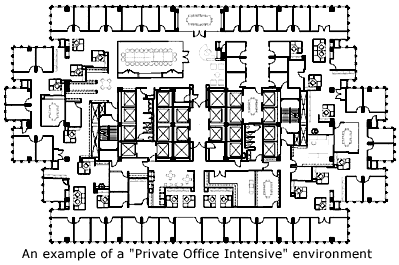
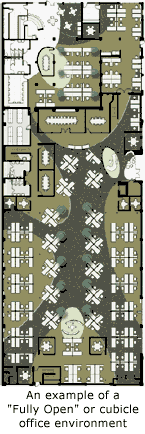
This is the number of staff in private or enclosed offices compared to those in systems furniture or open cubicles. Generally enclosed offices take up more space on a per person basis, so this ratio can have a direct impact on total space required. It also will have a big impact on the corporate culture and it can affect how your firm is perceived in the marketplace by both clients and potential candidates for hire. Law firms, large accounting firms and some software firms generally have a higher private office ratio than average, whereas computer hardware, telecom companies and other horizontally managed firms tend to favor a more open office environment with a lower than average private office ratio. Both approaches are valid for the respective organizations and depend on many factors within the company. Security, communication between staff, levels of hierarchy in management and other cultural factors all play a role in the definition of this ratio. This should be considered carefully before locking in the desired size of a lease space for consideration.
Conference Room Ratio
The ratio between number of staff served by each conference room is another metric for programming a space requirement. Firms operating in predominantly open office environments tend to need more rooms for private meetings between staff, both for small personnel meetings as well as large team or group meetings. This ratio can range from one conference room to 10 employees in an all open office environment to one conference room per 20 employees in a private office-rich environment. This ratio should be carefully considered and your architect can guide you to an appropriate ratio based on discussions with management. Once the private/open ratio is established, the architect will then be able to recommend an appropriate amount of conferencing rooms or other spaces and the resultant space requirements.
Circulation Factors
At first glance it may appear simple to just list all the spaces needed, along with their respective sizes and arrive at a total square footage requirement; however, additional space should be allocated to account for hallways and circulation paths within your space. This can vary dramatically depending on how efficient a layout that can be accomplished within a given building footprint.
For example, the dimension between the outside wall of the building and the interior building core rooms (toilet rooms, elevator shafts, etc.) should allow for hallway to give access to one or more rooms on each side of the hallway. A low dimension here will likely mean only one side of the hallway (referred to as “single loaded”) will serve the rooms and the circulation factor in this type of area will be higher. Where this dimension is adequate to serve rooms on either side of the hallway (or “double loaded”) this area is more efficient and will have a lower circulation factor. Usually for early planning purposes this factor is established at 25-35 % of the room/cubicle area. Once again, the enclosed office/cubicle ratio will affect this number, but your architect should be able to help you determine the appropriate ratio for your organization.
Sizing the Rooms
Here’s where most people start listing the numbers of staff and their respective spaces. How big to make the spaces naturally will affect the overall square footage so care must be taken to size the rooms appropriately for the given activity. Listed below are some of the more common rooms in an office environment. The actual room size is a function of many factors, and they should be reviewed with your architect to determine the appropriateness for your operations.
Private Offices
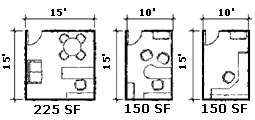
An office of 20'x15' can easily accommodate a senior executive desk, credenza, a conference table for 4 people and lounge seating for 2-3. This size is not uncommon for the CEO’s office in small to mid-sized companies.
An office of 15'x15' can include an executive desk and credenza, a conference table for 3-4 people and either a bookshelf or a small sofa for 2-3. This size is what we normally find for vice-presidents of mid-sized firms.
The 10'x15' office is very prevalent these days and can fit a mid-manager desk and return, two guest chairs and a bookshelf.
Some offices at the smaller end of the spectrum are 10'x12' or an even smaller 10'x10'. At this size a regular size desk and return are possible along with two guest chairs.
Cubicle Sizes
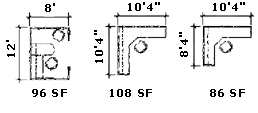
These vary greatly depending on the systems furniture manufacturer’s panel and work surface modules, panel thicknesses and clustering capabilities. Popular sizes are roughly 9'x12' for middle managers or engineers with multiple computer systems; 8'x10' for engineers or senior staff; 8'x8' for general staff; and 8'x6' or 6'x6' for administrative or telephone support personnel. Your firm will likely vary somewhat from these sizes, but the module areas in square feet will most probably be similar. Once again your architect is the best person to guide you to a reasonable module standard.
Conference Rooms

The appropriate size for a conference room depends on a multitude of factors (i.e., Audio Visual needs, maximum group size vs. typical group size, frequency of use, video and teleconference requirements); however if you allocate 20-25 USF per seat in the early planning stages you will be allowing sufficient space which can then be fined-tuned in the Space Planning or design phase later on.
On-site Training
Firms dedicated to keeping their company current with the advances in technology are usually committed to the ongoing training of their staff (and many times these firms will do on-site training of their clients’ staff as well), therefore the space program will include a need for special in-house training rooms. If you plan on having tablet arm type seating allow 20 USF per person. If your training involves people seated at tables with computer monitors allow 50-60 USF per person. (Depending on the frequency of use, you might consider renting off-site facilities which can then be paid for on a per use basis, in lieu of burdening your real estate overhead. This should be discussed with your architect and broker prior to committing to a lease.)
Avoiding Common Pitfalls
Your architect and broker form an important team in the leasing process. Optimally they should have a track record of working together to get you the best space possible for the least rent commitment. They will provide all the assistance you will need to find an appropriate space to lease on your terms. But there are some things which you should consider so that you are not caught off-guard as you are reviewing potential lease spaces.
Usable Square Feet versus Rentable Square Feet
Your architect will normally calculate your need based on Usable Square Feet (USF) as defined by standards established by the Building Owners and Managers Association (BOMA). Depending on the building and the nature of your occupancy (retail, full-floor or multi-tenant floor) a load factor multiplier will be applied by the landlord to the square footage you actually occupy in your space or USF. The result is a Rentable Square Footage (RSF). This load factor accounts for your pro-rated share of the Common Area in the building that you share with other tenants (i.e. building lobbies, corridors, toilet rooms etc.)
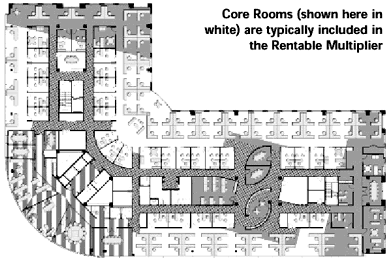
The RSF is typically what rent rates are quoted on, so when communicating your space needs to your broker be clear that your needs are calculated using USF. The broker will then adjust for the correct RSF amount depending on the building and the respective load factor. This load factor is important when comparing buildings as it can vary significantly and it goes directly to the bottom line.
Allow For Enough Growth
It usually is hard to plan accurately for growth, but sometimes good indications can be derived from department budget projections, headcount projections, hiring histories and other market indicators. Usually some additional space needs to be included for growth. Optimally the new space should be sized to accommodate all the staff projected through the midterm in the lease, e.g. 30 people are expected on move-in and your firm should grow to 50 by the end of the lease, then ideally you should plan a space for about 40 people. Also, if you reconfigure teams often you should allow for additional space that will be needed for staging the moves.
Steps in Space Programming
Hire the architect early on in the process
This will ensure you have an accurate heads-up picture of your space requirements.
Collect Relevant Data
Assemble any Organizational Charts, Headcount Projections, Furniture and Equipment Inventories, As-built Floor Plans of Existing Space, CADD Files, Etc.
This can greatly assist your broker-architect team in determining a meaningful estimate of the required area.
Adjust for Changes in the Culture—Allow for Flexibility
Now is the time to make sure you plan for the necessary space to foster productivity in the new office.
Make sure your firm has sufficient space to adjust easily to market forces.
Calculate Growth Space
Include room for a reasonable growth in your staff. Usually you can’t grow revenues without some increase in staff.
Do Test Fit Plan(s) for Targeted Building(s)
Have your architect do check layouts of typical floors or areas to confirm density ratios, furniture and office module compatibility.
This will allow you to uniformly compare the various potential spaces from both a design as well as an efficiency standpoint.
Start Early!
Don’t get caught rushing. A mistake in this early preplanning stage will most likely mean you’ll soon be going through the process all over again.
A little up front analysis and planning, through the help of a professional architect with experience in office planning, can go a long way in laying the necessary groundwork for a smooth transition to your new office. Assuming your architect has performed the proper analyses and documented accurately your needs for the new office, you can be assured that ultimately your new company home will be a good fit for your organization. And just as importantly the subsequent phases of design and construction will go more quickly and without surprises.



